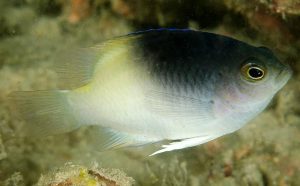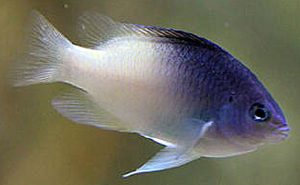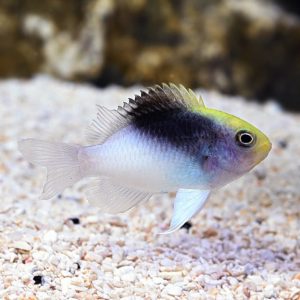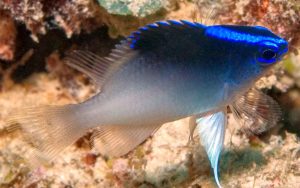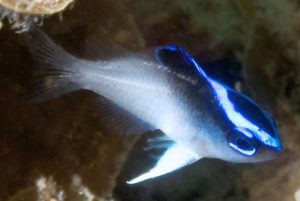Rolland’s Damselfish (Chrysiptera rollandi) known to tropical fish keeping enthusiasts as the Black Cap Damselfish, or Rolland’s Demoiselle are distributed throughout the Indian and Western Pacific Oceans and range from the Andaman Sea, north to the Philippines, and south to the Great Barrier Reef and New Caledonia. Specimens have also been recorded from Tonga
Rolland’s Damselfish are found singly and in small schools among Acropora type corals and coral rubble in harbors, lagoons, and the outer reef slopes at depths from 6 to 120 feet where they feed mainly on zooplankton.
Like Similar Damselfish (Pomacentrus similis), Chrysiptera rollandi are a peaceful, non-migratory, reef dependent species that feed on small crustaceans, microalgae, and zooplankton among the substrate and corals during daylight hours, and shelter among the coral branches during the night for protection from predators. One or two males will usually defend a single branching SPS coral head with a harem of juveniles and females, and in return for the shelter provided by the coral, remove unwanted algal growth. Although they are extremely protective of their territories (coral heads), they do not aggressively extend their existing territories.
Rolland’s Damselfish have a light gray to white body and are a darker blue gray towards the head and the front portion of the dorsal area. The pectoral, anal, caudal, and rear portion of the dorsal fins are a white to translucent. Mature adults have two bright iridescent blue stripes above the eyes.
At least two color variants of Rolland’s Damselfish exist. One variant has yellow extending above the eye to the first
few dorsal fin rays, followed by a bluish black band that fades to white, and another variant with a bluish black band that takes up the front half of the body, followed by white with vibrant blue spotting and streaks on the head.
Recent DNA analysis suggesting that Rolland’s Damselfish can be geographically separated into at least three distinct diurnal species; individuals from the Andaman Sea, individuals from the Indo Australian archipelago, and individuals from the southern Coral Sea and New Caledonia could be responsible for the color variants.
Because Black Cap Damselfish are less aggressive than other damsels, they do not require as large of an aquarium.
A small odd numbered group of Black Cap Damselfish is best housed in a mature FOWLR or reef aquarium of at least 30 gallon capacity with a sand or fine gravel substrate and plenty of live rock arranged into crevices, caves, and overhangs for them to hide among. Rolland’s Damselfish are completely reef safe and will not disturb corals or invertebrates in a reef tank. Although solitary individuals will occasionally become territorial towards their own kind or similar sized fish, they will generally ignore other fish in a peaceful species tank.
Small, odd numbered groups of juvenile Rolland’s Damselfish can be safely housed in a FOWLR tank with other semi aggressive species without any problems provided plenty of hiding places are available. Although they will become more territorial as they mature, it usually presents no problems in a large tank with plenty of live rock arranged into hiding places.
Individual Chrysiptera rollandi housed in a FOWLR tank can deteriorate quickly and die when they become stressed in the aquarium however, in small shoals, they can flourish for years.
Although Rolland’s Damselfish have been bred in captivity, the larvae are difficult to rear. Mated pairs follow a benthic egg laying cycle. After a brief courtship “dance”, the female lays her small adhesive eggs on a rock or shell on the substrate. After the male fertilizes the demersal eggs, he guards and aerates them until they hatch. The tiny fry in their larval stage will drift with the current as plankton feeding on zooplankton and phytoplankton before settling to the bottom as partially developed damselfish. Males often mate with multiple females in the harem during the spawning season.
In their natural habitat Rolland’s Damselfish are omnivores that are typically found foraging on zooplankton and algae among large heads of Acropora sp,. In an aquarium environment they are not picky eaters and will accept flakes, pellets, and almost all meaty and herbivorous preparations. Small portions of Brine Shrimp, Spirulina Flakes, Frozen Foods, Mysis
, Zooplankton
, and finely chopped seafoods should be fed several times a day to minimize aggression in the tank.
Rolland’s Damselfish (Chrysiptera rollandi) are normally available to tropical fish keeping enthusiasts in specialty fish shops and online from wholesalers, trans shippers, and retailers at prices varying from $4.99 to $19.99 at approximate purchase sizes: 3/4″ to 1-1/4″
Minimum Tank Size: 30 gallons
Aquarium Type: Reef or FOLR
Care Level: Easy
Temperament: Semi Aggressive
Aquarium Hardiness: Hardy
Water Conditions: 72-78°F, dKH 8 to 12 , pH 8.1 – 8.4, sg 1.020-1.025
Max. Size: 3″
Color Form: Black, White, Yellow
Diet: Omnivore
Compatibility: Reef
Origin: Indo Pacific, Sri Lanka, Indonesia
Family: Pomacentridae
Lifespan: 3-5 years
Aquarist Experience Level: Beginner


